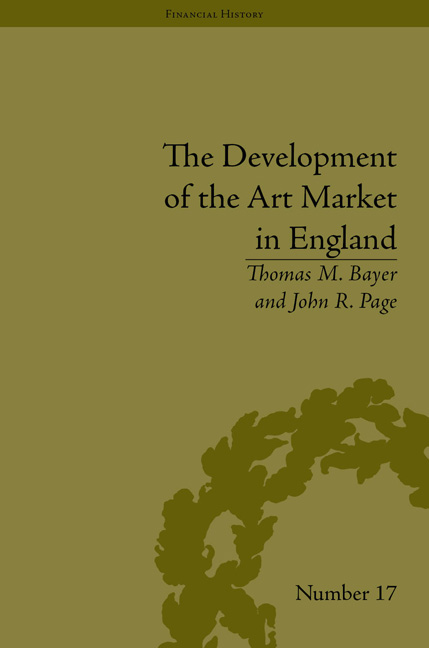Book contents
- Frontmatter
- CONTENTS
- Acknowledgements
- List of Figures and Tables
- Dedication
- Introduction
- 1 The Early Stages: From the Netherlands to Great Britain
- 2 The Commoditization of Theories of Art
- 3 The Painter as Homo Economicus
- 4 Critics and Auctions
- 5 The Evolution of Picture-Dealing
- 6 The Victorian Era
- 7 ‘Working the Oracle’: The Tools of the Trade
- 8 The Formation of a Nexus: A Story of Christie's
- 9 Commoditization and the Artist as Producer: Product Differentiation and the Domestication of Pictures
- 10 The End of the ‘Golden Age’
- 11 Postscript: A Perpetual Innovative Whirl
- Notes
- Works Cited
- Index
1 - The Early Stages: From the Netherlands to Great Britain
- Frontmatter
- CONTENTS
- Acknowledgements
- List of Figures and Tables
- Dedication
- Introduction
- 1 The Early Stages: From the Netherlands to Great Britain
- 2 The Commoditization of Theories of Art
- 3 The Painter as Homo Economicus
- 4 Critics and Auctions
- 5 The Evolution of Picture-Dealing
- 6 The Victorian Era
- 7 ‘Working the Oracle’: The Tools of the Trade
- 8 The Formation of a Nexus: A Story of Christie's
- 9 Commoditization and the Artist as Producer: Product Differentiation and the Domestication of Pictures
- 10 The End of the ‘Golden Age’
- 11 Postscript: A Perpetual Innovative Whirl
- Notes
- Works Cited
- Index
Summary
The Netherlands
An immediate consequence of the system of anonymous patronage in the Netherlands in the sixteenth century was a process innovation in marketing. Untying the production of art from marketing improved the effectiveness of exchange and, as a result, a modern art market came into existence. Separately, production and marketing became more efficient internally, in their interaction with each other and with other markets.
On the supply side, art producers adopted cost-reducing measures, such as switching from panel to canvas painting: canvas was cheaper, easier to prepare, lighter in weight, and less sensitive to climate changes. Division of labour resulted in specialization in subjects, copying, formula painting and mechanical repetition of designs for workshop production. Paintings, on average, decreased in size: smaller paintings were better suited for the urban residences of the new patrons, and sellers could display a larger number of selections, thereby increasing the opportunities for sales. Market considerations were also responsible for the outpouring of engravings, published in large editions and sold inexpensively to the general population. Specific stylistic changes, such as the adoption by certain artists of a more monochromatic execution and the popularity of landscapes or grisailles were further manifestations of producers’ responses to changing market conditions.
Process innovation in marketing led to the spread of art fairs, officially sanctioned art auctions, art lotteries and, ultimately, by the end of the fifteenth century, to the establishment of professionally operated art galleries.
- Type
- Chapter
- Information
- The Development of the Art Market in EnglandMoney as Muse, 1730–1900, pp. 13 - 28Publisher: Pickering & ChattoFirst published in: 2014



